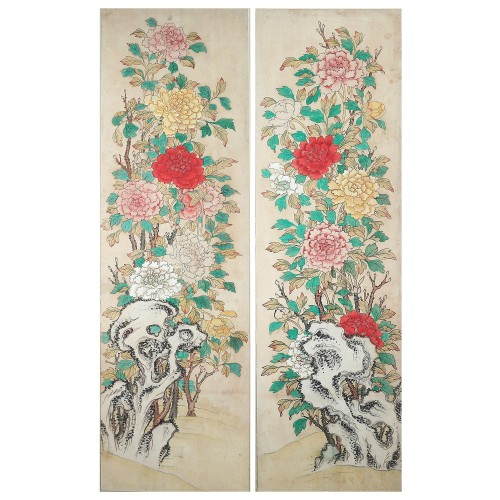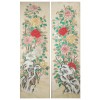본문
궁모란도(宮牡丹圖)는 부귀와 영화를 상징하는 대표적인 길상화로, 조선 초기에는 화조화의 일부로 그려졌으나 후기에는 단독 화제로 발전하였습니다.
18세기 이후 발묵기법과 몰골법을 활용해 사의적 표현이 강조되었고, 다양한 채색과 구도를 통해 화훼 회화의 중심 주제가 되었습니다.
조선 궁중 모란도는 도상에 크게 두 형태로 구분됩니다. 하나는 화면 전체에 모란나무가 연결된 일지병풍 형식이고, 다른 하나는 둔덕 위 모란이 각 폭마다 독립적으로 배치된 형식입니다.
해당 모란도는, 후자에 해당하며 만개한 모란을 다채로운 색채로 묘사하여 화려함과 기품이 드러나고, 병풍 하단에 괴석이 함께 배치되어 조형적 안정감과 장수와 길상이라는 상징적 의미가 더해졌습니다.
━━━━━
《宫牡丹图》是象征富贵荣华的代表性吉祥图。朝鲜初期多作为花鸟画的一部分出现,至后期逐渐发展为独立的绘画题材。
18世纪以后,作品广泛运用泼墨技法与没骨法,强调写意表现,并通过丰富的设色与多样的构图,成为朝鲜花卉绘画的核心主题之一。
朝鲜宫廷中的牡丹图在图像构成上主要分为两种类型:一种是牡丹树贯穿整个画面的“一枝式”屏风构图;另一种则是在每一屏风幅面上独立描绘分布于山丘之上的牡丹。
本幅作品属于后者,以绚丽多彩的色调描绘盛开的牡丹,展现出华丽与高雅的气韵。画面下方配置奇石,不仅增强构图的稳定感,也赋予作品长寿与吉祥的象征意义。
━━━━━
Gung Morando (宮牡丹圖), or a palace peony painting, is a representative auspicious painting symbolizing wealth and honor. In early Joseon, peonies were depicted as part of bird-and-flower compositions but later became a standalone theme.
After the 18th century, artistic techniques such as ink wash and outline-free brushwork were employed to emphasize expression and mood. Diverse use of color and composition established peony paintings as a central subject of floral painting.
Palatial peony paintings from Joseon generally fall into two compositional types: one features a continuous peony tree across an entire folding screen (a one-branch screen format), and the other arranges peony clusters independently on mounds within each panel.
The current painting follows the latter format, showcasing fully bloomed peonies rendered in vibrant colors, exuding elegance and splendor. Ornamental rocks are arranged at the bottom of the screen, adding compositional stability and symbolic meanings of longevity and good fortune.

